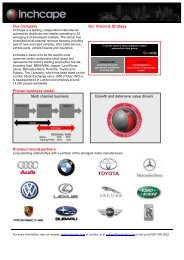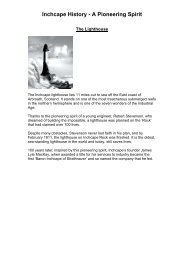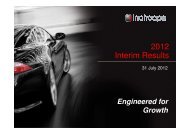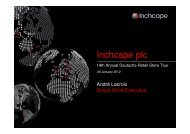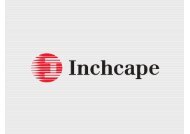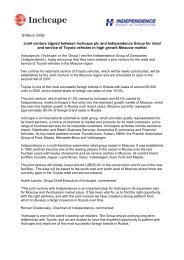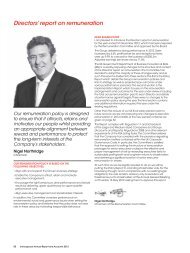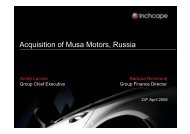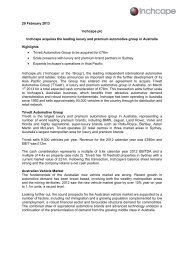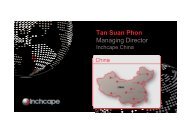Full Annual Report - Inchcape
Full Annual Report - Inchcape
Full Annual Report - Inchcape
You also want an ePaper? Increase the reach of your titles
YUMPU automatically turns print PDFs into web optimized ePapers that Google loves.
Financial statements<br />
Accounting policies continued<br />
Other intangible assets<br />
Intangible assets, when acquired separately from a business (including computer software), are carried at cost less accumulated<br />
amortisation and impairment losses. Costs comprise purchase price from third parties as well as internally generated development<br />
costs where relevant. Amortisation is provided on a straight line basis to allocate the cost of the asset over its estimated useful life, which<br />
in the case of computer software is three to seven years. Amortisation is recognised in the consolidated income statement within ‘net<br />
operating expenses’.<br />
Intangible assets acquired as part of a business combination (including back orders and customer contracts) are capitalised separately<br />
from goodwill if the fair value can be measured reliably on initial recognition. These intangible assets are amortised over their estimated<br />
useful life, which is generally less than a year.<br />
Property, plant and equipment<br />
Property, plant and equipment is stated at cost less accumulated depreciation and impairment losses. Cost comprises the purchase<br />
price and directly attributable costs of the asset and includes, where relevant, capitalised borrowing costs. Depreciation is based on<br />
cost less estimated residual value and is provided, except for freehold land which is not depreciated, on a straight line basis over the<br />
estimated useful life of the asset. For the following categories, the annual rates used are:<br />
Freehold buildings and long leasehold buildings 2.0%<br />
Short leasehold buildings<br />
shorter of lease term or useful life<br />
Plant, machinery and equipment 5.0% – 33.3%<br />
Interest in leased vehicles<br />
over the lease term<br />
The residual values and useful lives of all assets are reviewed at least at the end of each reporting period.<br />
Impairment<br />
Assets that are subject to amortisation or depreciation are reviewed for impairment whenever events or circumstances indicate that the<br />
carrying amount may not be recoverable.<br />
In addition, goodwill is not subject to amortisation but is tested at least annually for impairment. An impairment loss is recognised for the<br />
amount by which the asset’s carrying amount exceeds its recoverable amount, the latter being the higher of the asset’s fair value less<br />
costs to sell and value in use. Value in use calculations are performed using cash flow projections, discounted at a pre-tax rate which<br />
reflects the asset specific risks and the time value of money.<br />
A provision for impairment of trade receivables is established when there is objective evidence that the Group will not be able to collect<br />
all amounts due according to the original terms of the receivables. The carrying amount of the asset is reduced through the use of an<br />
allowance account, and the amount of the loss is recognised in the consolidated income statement within ‘net operating expenses’.<br />
When a trade receivable is uncollectible, it is written off against the allowance account for trade receivables. Subsequent recoveries of<br />
amounts previously written off are credited against ‘net operating expenses’ in the consolidated income statement.<br />
Inventories<br />
Inventories are stated at the lower of cost and net realisable value. Cost comprises expenditure incurred in bringing inventories to their<br />
present location and condition. Net realisable value represents the estimated selling price less all estimated costs of completion and<br />
costs to be incurred in marketing, selling and distribution. Used vehicles are carried at the lower of cost or fair value less costs to sell,<br />
generally based on external market data available for used vehicles.<br />
Vehicles held on consignment which are deemed in substance to be assets of the Group are included within ‘inventories’ with the<br />
corresponding liability included within ‘trade and other payables’.<br />
Inventory can be held on deferred payment terms. All costs associated with this deferral are expensed in the period in which they<br />
are incurred.<br />
Pensions and other post-retirement benefits<br />
The Group operates a number of retirement benefit schemes.<br />
The major schemes are defined benefit pension funds with assets held separately from the Group. The cost of providing benefits under<br />
the plans is determined separately for each plan using the projected unit credit actuarial valuation method.<br />
The current service cost and gains and losses on settlements and curtailments are included in ‘cost of sales’ or ‘net operating expenses’<br />
in the consolidated income statement. Past service costs are similarly included where the benefits have vested otherwise they are<br />
amortised on a straight line basis over the vesting period. The expected return on assets of funded defined benefit pension plans and<br />
the imputed interest on pension plan liabilities comprise the post-retirement benefit element of finance costs and finance income in the<br />
consolidated income statement.<br />
Differences between the actual and expected return on assets, changes in the retirement benefit obligation due to experience and<br />
changes in actuarial assumptions are included in the consolidated statement of comprehensive income in full in the period in which<br />
they arise.<br />
The Group’s contributions to defined contribution plans are charged to the consolidated income statement in the period to which the<br />
contributions relate.<br />
86<br />
<strong>Inchcape</strong> plc ¦ <strong>Annual</strong> <strong>Report</strong> and Accounts 2009






